Participants
Publications
Prototypes
Sponsors
| Jump to:
Participants Publications Prototypes Sponsors |
Related HCIL pages:
Summary of Dynamic Queries : Predecessor of Query Previews
Related HCIL pages:
Census Project : For other examples of Query Previews
Related HCIL pages:
NSF Project : For more general
examples of Query Previews
Research on Query Previews also continues in the context of our projects with the Census Bureau and the NSF.
Problems with the traditional query systems?
The traditional approach to querying is to use a form fill-in interface, but such an approach leads to user frustration when the query returns either zero hits or a very large number of hits. Often, users cannot even estimate the total number of hits their query would have returned as the system only returns the first 25 - 50 hits. It is difficult to estimate how much data is available on a given topic and how to increase or reduce result set sizes.
Dynamic query user interfaces apply the principles of direct manipulation to query formulation and imply:
Query Previews take advantage of the fact that in most cases, users are only interested in a subset of the entire database. Users are presented with generalized previews of the entire database using only the most salient attributes, they select rough ranges, and they are immediately given the availability of the data for their proposed query.
Once the scope has been sufficiently narrowed, a second query phase, called Query Refinement, can start. This phase is a dynamic query interface with all attributes and all records represented individually, but only for those selected in the Query Preview.
US Census Bureau maintains
large amounts of tabular data. Browsing these tables poses similar problems
that we aim to solve with the query preview approach. We believe query
previews can improve access to Census data in terms of user performance
and satisfaction. Below, we present a demo (1) built by using this approach
and 1990 US Census Income Data. This demo shows the distribution of householders
over three attributes, age, income level, and ethnic origin of the householder.
Each attribute is represented by a bar chart. Selecting bars from a chart
immediately updates the distribution of data over the other bar charts.
Hence, users can dynamically investigate a large space of charts by simply
selecting/deselecting bars. A separate bar represents the overall count
of householders that satisfy the current selection. In this example, we
first select the householders that are older than a certain age (2). Then
we select the high-income householders (3). Finally, we select a specific
ethnic origin (4) and fetch only the selected portion of the data (5).
Querying can continue over states and counties of this extracted portion.
If requested, users can change their previous selections and start investigating
a different portion of the data.
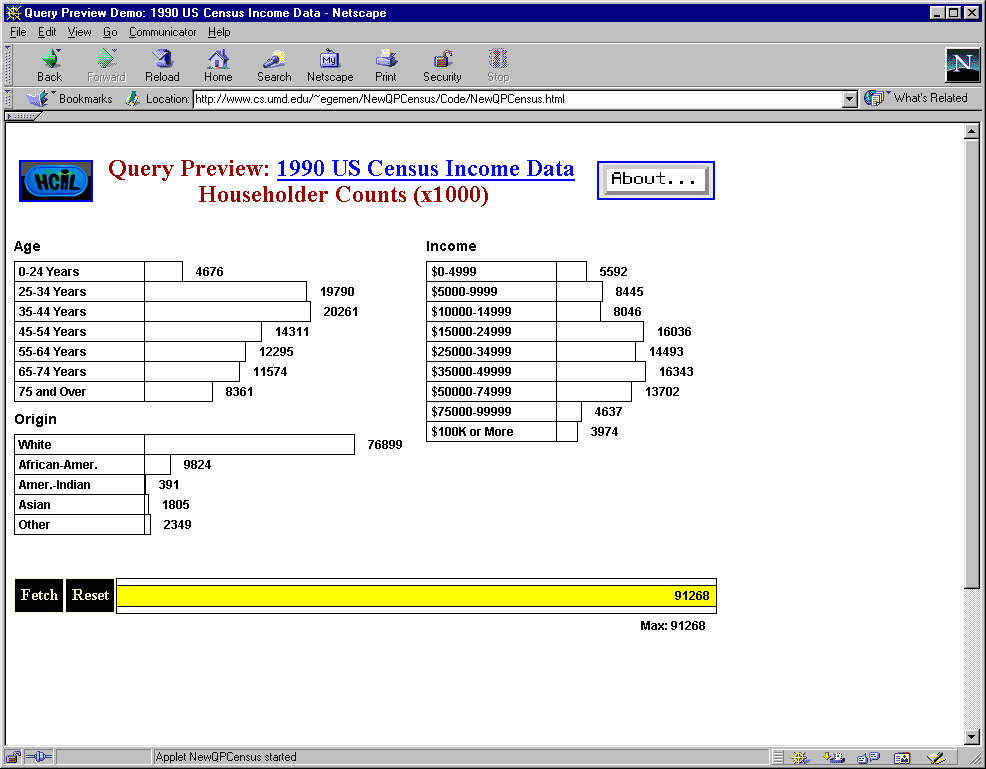 1
1 |
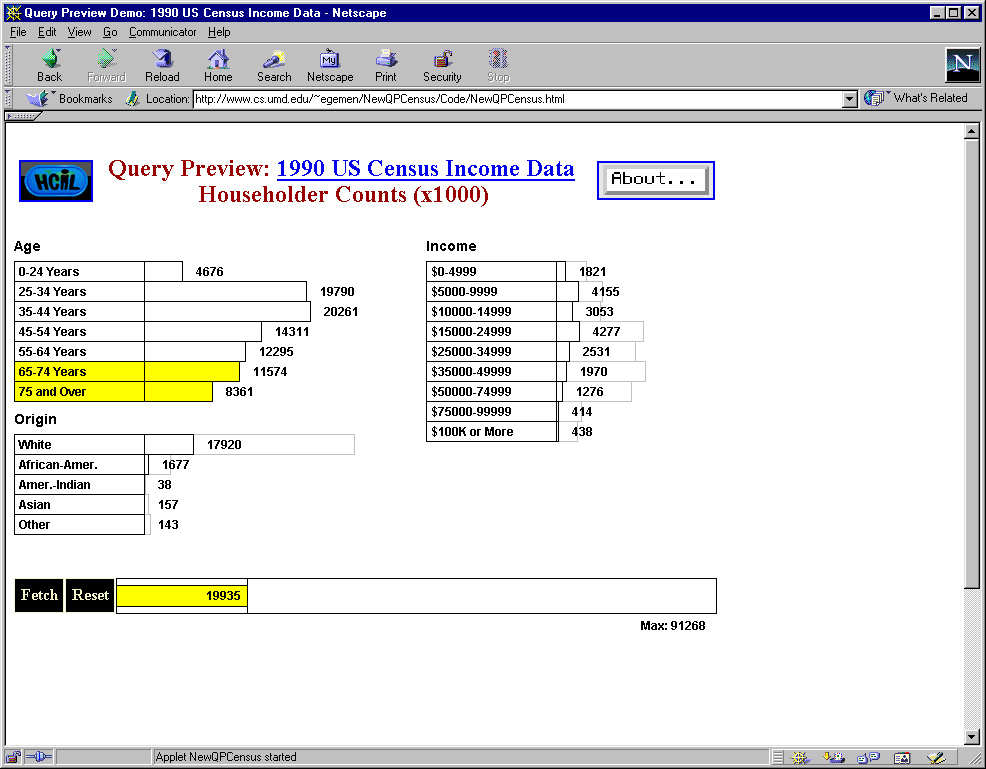 2
2 |
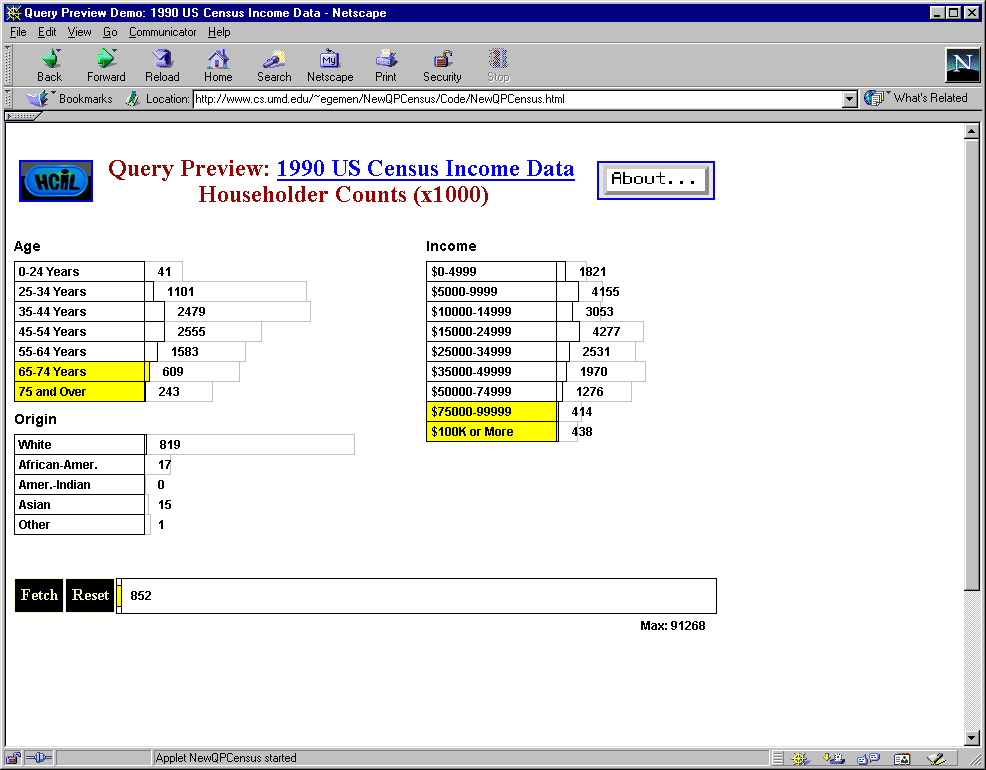 3
3 |
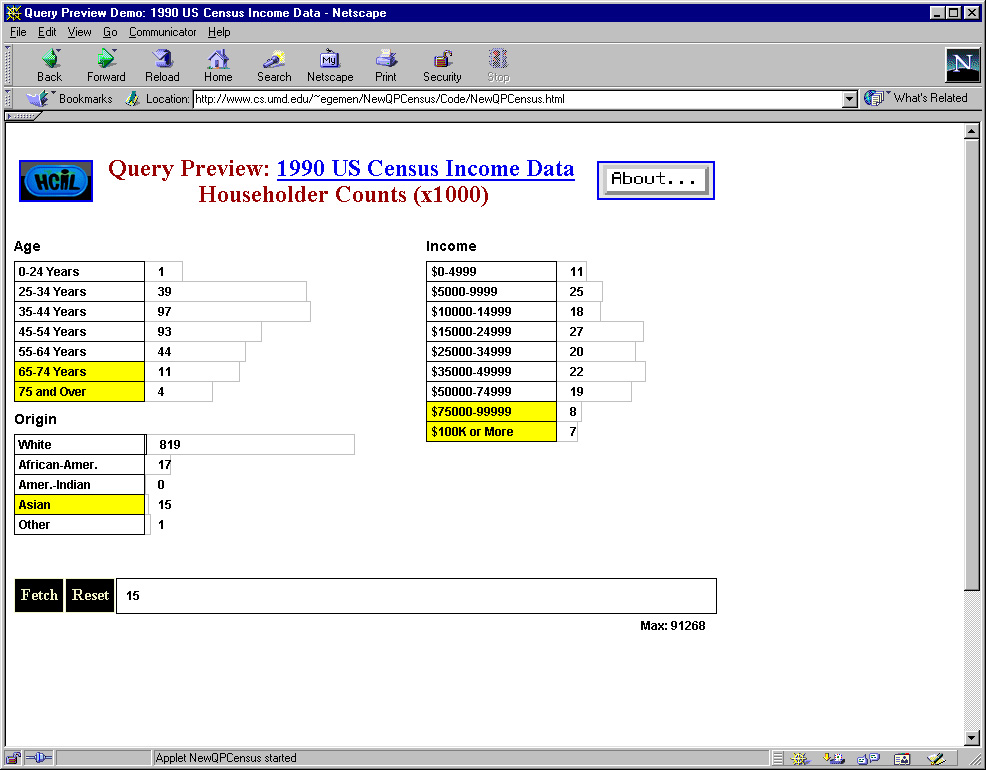 4
4 |
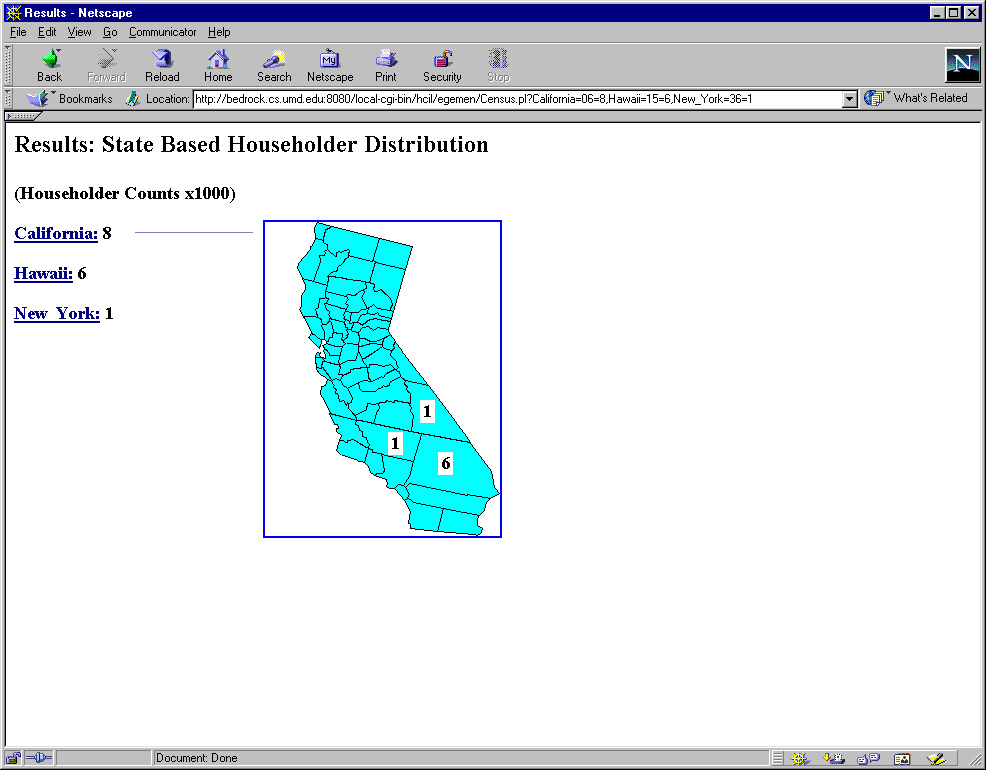 5
5 |
Related HCIL Pages:
QUIS: Questionnaire for User Interface Satisfaction.
Dynamic Queries
and Query Previews for Networked Information Systems: the case of NASA
EOSDIS
Generalized Query
Previews
Catherine Plaisant, Assistant Research Scientist (Project lead)
Ben Shneiderman, Professor Computer Science
Egemen Tanin, Graduate Research Assistant
Maya Ventkatraman, Faculty Research Assistant
Stephan Greene, Faculty Research Assistant
Richard Beigel, Associate Visiting Professor
Tom Bruns, Faculty Research Assistant
Khoa Doan, Post-Doctoral Researcher
Kawin Ngamkajornwiwat, Graduate Research Assistant
Laurent Cailleteau, visiting undergraduate studentand collaborators at Raytheon (Bob Harberts and Wenlan Feng) and at the Global Change Master Directory - GCMD (Lola Olsen, Gene Major, Steve Johns, Chris Gokey)
Beigel, R., Tanin, E.,
The Geometry of Browsing,
LATIN'98: Theoretical Informatics,
Lecture Notes in Computer Science, vol 1380, pp 331-340
, 1998
(Also compressed PS file)
Tanin, E, Lotem, A., Haddadin, I., Shneiderman, B., Plaisant, C., Slaughter,
L. (Jan 98)
Facilitating
Network Data Exploration with Query Previews: A Study of User Performance
and Preference
To appear in
Greene, S., Tanin, E., Plaisant, C., Shneiderman, B., Mushlin, R., Olsen, L., Major, G., and Johns, S. (1997)
The
End of Zero-Hit Queries: Query Previews for NASA's Global Change Master
Directory
International Journal of Digital Libraries, Vol. 2, No. 2+3 (79-90), 1999
CS-TR-3856, UMIACS-TR-97-84
*
Khoa Doan, Catherine Plaisant, Ben Shneiderman, and Tom Bruns
Interface
and Data Architecture for Query Preview in Networked Information Systems
Technical report (April 1997)
- revised version in ACM TOIS as
Practice and Experience Paper.
A short early version also appeared in SIGMOD Record, Vol.26,
No.1, pp. 75-81 March 1997, as Previews for Networked Information Systems:
A Case Study with NASA Environmental Data
Tanin, E., Beigel, R. and Shneiderman, B. (Oct 1997)
Interface
Design and Evaluation of Incremental Data Structures and Algorithms for
Dynamic Query Interfaces,
Proceedings of the IEEE Information Visualization '97, Phoenix,
Arizona, pp 81-86
Tanin, E., Beigel, R., and Shneiderman, B. (Dec. 1996)
Incremental
Data Structures and Algorithms for Dynamic Query Interfaces
Workshop on New Paradigms in Information Visualization and
Manipulation, Fifth ACM International Conference on Information and
Knowledge Management (CIKM '96) (Rockville, MD, Nov. 16, 1996) 12-15.
Also in SIGMOD Record, Vol. 25, No. 4 (21-24), December 1996
Plaisant, C., Bruns, T., Shneiderman, B., Doan, K. (June 1996) Query
Previews in Networked Information Systems: the Case of EOSDIS
in CHI 97 VIDEO PROGRAM , Atlanta GA, 22-27 March 1997, ACM,
New York NY. (also in the HCIL
1996 video report)
Doan, K., Plaisant, C., Shneiderman, B.
Query
previews in networked information systems,
Proc. of the Third Forum on Research and Technology Advances in
Digital Libraries, ADL '96 (Washington, DC, May 13-15, 1996) IEEE CS
Press, 120-129.
An abstract also appeared as "Architecture of dynamic query user interface
for networked information systems" in on-line Proc. of NASA Science
Information Systems Interoperability Conference (College Park, MD,
Nov. 6-9, 1995) CS-TR-3524, CAR-TR-788, ISR-TR-95-90.
Prototyping history: (Please use recently upgraded browsers only)
| 2001 | see NSF project |
Query Preview work continues in the context of our NSF project. | |
| 2000 | see Census project |
Query Preview work also continues in the context of our Census project. | 1999 | Latest NASA demos not here | The latest prototypes were developed in collaboration with Raytheon ( Bob Harberts). Please contact him directly for an update. |
| Spring 99 | Multivalued attribute data techniques | techniques scale to any number of records, and therefore could be used for EOSDIS inventory searches | |
| FALL 98 | SAR technique: Single Attribute, Range only |
This technique has a more restrictive interface but preserves the counts. Warning: all
three attribute applets work, but the preview data is not updated when
users change attribute yet (need connection to real data server)
| |
| . | Binary Previews:
older version Two-attributes Three-attributes Alternative interface |
Query Preview without counts, only tells if there is data or not(Work in progress) | |
| . | GCMD hybrid technique | This technique deals with multivalued data but could not scale to more than about 10,000 record, therefore only useful for EOSDIS directory searches | |
| January 1998: | GCMD demo (at GCMD) | Beta version running at NASA Global Change Master Directory (GCMD) | |
| September 1997: | Earlier version | Older version of the GCMD prototype at HCIL | |
| Summer 1997: | Initial Java Prototype with GCMD data | First operational prototype implemented by Stephen Greene and Egemen Tanin with NASA's Global Change Master Directory (GCMD). Results are returned from the GCMD database. A second level of preview is used instead of our refinement design. | |
| Summer 1997: | Alternative Prototype with science-classified GCMD data | This prototype is similar to the above version, though here the topic attributes of the data are classified by science (abandoned for now) | |
| . | Earlier prototypes | Earlier experiments and designs of Query Previews and algorithm test for dynamic queries | |
| Fall 1996: | DQ with 100,000 points | New algorithms now allow Dynamic Queries updates in less than 100 msec. with 100,000 points and 10 sliders. | |
| Fall 1996: | Pyramid | Pyramid is an experimental year range selector written in Java. This small demo is not placed within its proper context and was never completed. Other version:: Pyramid-2 | |
| Spring 1996: | Java Prototype | A first prototype was developed in Java. The data used is hypothetical. No connection to real database. The refinement phase is only a rough mockup. The results of the preview are not really passed to the refinement. PC browsers gave the best results. | |
| Fall 1995: | TCL/TK Prototype (Screen Prints) | Khoa went on to develop a prototype in Tcl/tk. Tom Bruns later refined the prototype, and created this series of screenshots. A video is also available that shows this prototype in action. | |
| Fall 95 and Summer 98 | TCL/TK
Prototype (Working Version)
Download Plugin |
This is a version of the initial prototype that has been revised so that it can run on a browser. | |
| Summer 1995: | Visual Basic Prototype | Khoa Doan developed the first prototype illustrating the Query Preview/Quer Refinement approach, based on a design by Catherine Plaisant and Ben Shneiderman. |
Sponsors: This work is supported in part by NASA ESDIS (NAG 52895 and NAGW 2777). The recent work was done in collaboration with the Global Change Master Directory and with the V0-IMS team at Raytheon.